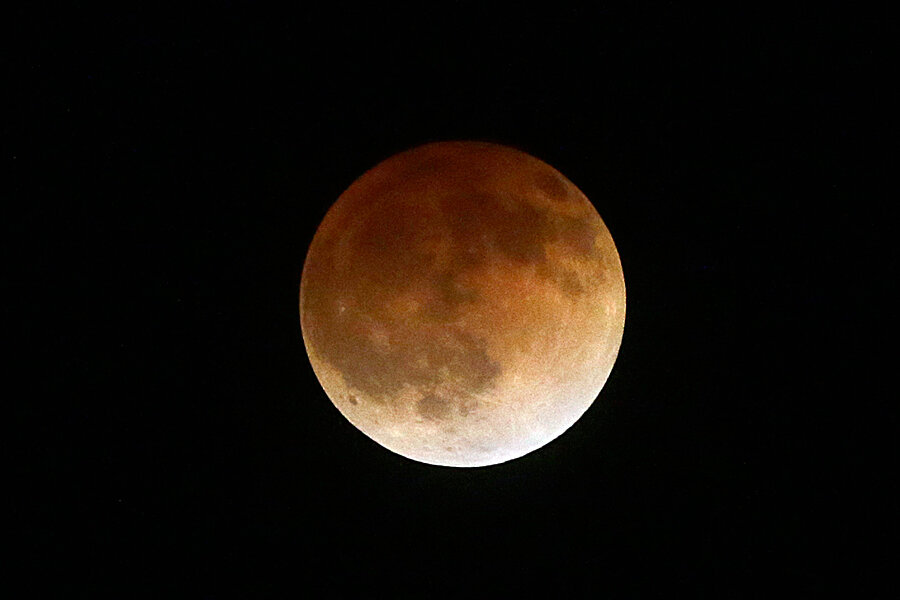Scientists studying moon's 'DNA' trace its ancestry to titanic collision
Loading...
When a theorized object dubbed Theia crossed paths with the early Earth 4.5 billion years ago, the encounter was brutal. Debris from the titanic collision is widely held to have formed the moon.
Despite years of effort, however, scientists have been hard-pressed to find the geophysical equivalent of Theia's DNA mixed in with Earth's in lunar rocks. That should have been a natural outcome as debris from both objects coalesced into a new one.
Now a team of German scientists has reported the first geochemical evidence for Earth's encounter with Theia (in Greek mythology, the mother of Selene, the goddess of the moon) in samples of moon rocks gather by Apollo astronauts. The discovery fills an important gap in the chain of evidence for the moon's origin.
"We can now be reasonably sure that the giant collision took place," Daniel Herwartz, a geochemist at the University of Cologne in Germany and the lead author of a formal report of the team's analysis of the moon-rock samples, said in a statement. The report is set to appear in Friday's issue of the journal Science.
The report also opens a wider window on Theia's geochemistry and holds clues as to how much of today's moon is composed of Theia's leftovers, the team explains.
Of the more than 150 moons orbiting planets or dwarf planets in the solar system, Earth's moon is an odd one. Virtually all the others formed either from discs of dust and gas surrounding the planets that host them, or from asteroids flitting through the solar system that were captured by the planets' gravity.
On the other hand an origin in a collision better fits some of the moon’s characteristics, researchers say. For instance, it is relatively poor, compared with other moons, in evaporated elements or compounds that evaporate at moderate rates, such as water. Its core also is unusually small for an object its size.
Combined with the relative rotation rates of the Earth and moon, these traits point to an early collision, researchers say.
Modeling experiments that recreate the collision have suggested that between 70 and 90 percent of the moon should be made up of Theia's material. But measurements of meteorites from the moon, as well as of moon rocks, have shown a remarkably Earth-like composition.
Until now.
Researchers have noted that the geochemical make-up of objects in the solar system is quite diverse, reflecting the material available to them in the regions where they formed. Since Theia was an interloper, key signatures in its geochemistry should be different than Earth's.
Previous teams have tried to uncover Theia's geochemical signatures. But the results yielded no significant difference between these signatures in Earth rocks and moon rocks, so the teams reported no difference, Dr. Herwartz writes in an e-mail.
For their work, Herwartz and colleagues looked for a difference in the ratio of two oxygen isotopes, oxygen-17 and oxygen-16, between moon rocks and Earth rocks. In doing so, they applied a new approach to making their measurements. They purified their samples more extensively than predecessors had to improve their odds of detecting even small differences in the oxygen ratios. And they processed the samples for 90 minutes, longer than others had, to build up a signature that otherwise might still have been too faint to be meaningful.
The researchers first analyzed lunar meteorites. But weathering after the lunar rocks fell to Earth made it tough to spot any differences between the relative abundance of oxygen-17 in Earth and moon rocks.
Samples from carefully curated moon rocks that NASA provided from Apollo missions 11, 12, and 16, however, did yield a different isotope signature, with higher oxygen-17 to oxygen-16 ratios than Earth rocks. For every million oxygen-16 isotopes, the moon rocks had 12 more oxygen-17 isotopes than did Earth rocks.
"The differences are small and difficult to detect, but they are there," Herwartz said.
If the results hold up to further scrutiny, they would imply that Theia's material accounts for only about 40 percent of the material making up the moon, with Earth having donated the rest, the team estimates. And they suggest that Theia may have a composition similar to a class of meteors known as enstatite chondrites.
Of all the meteorites that land on Earth, these are the most rare. Their low oxygen content suggests they may have formed near the center of the disc of dust and gas that surrounded the young sun. Some researchers suggest that enstatite chondrites formed inside Mercury's orbit.







